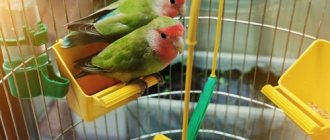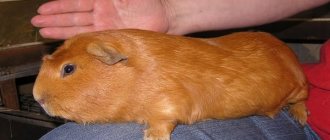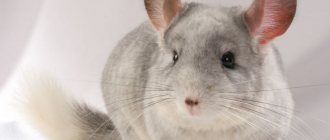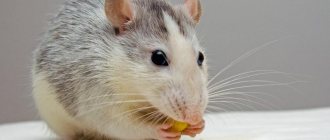Review author: “ZooVita”
The dwarf fold ram is the most popular breed of decorative rabbits. A cute animal with a charming face, cute floppy ears and a calm character, it is most suitable for children and beginners.
From the outside, a rabbit may seem like a toy, but it is a living creature that requires attention, care, and responsibility from its owner. In return, the handsome furry man is able to give love, devoted friendship, and a lot of pleasant emotions.
Before purchasing an animal, you need to study its habits, behavior, know what to feed a dwarf rabbit, and how to care for it.
History of the breed
Unusual lop-eared rabbits look very similar to small lambs. For the first time, C. Darwin spoke about them, who noticed in the litter of ordinary animals with erect ears, fold-eared babies. This phenomenon has interested breeders.
Already by the middle of the 20th century, breeders from Holland developed a new breed by crossing small decorative rabbits with French Folds.
Since 1964, the breed has been officially recognized. Dwarf rams appeared in Russia in the late 90s and immediately won the hearts of pet lovers.
Hotot
A small white rabbit with a black border around the eyes. The weight of this baby is a little more than 1 kg. The ears are small, up to 7 cm long. The fur is soft and pleasant to the touch.
These pets are very cheerful, they need to exercise a lot, and they are always happy to play with their owner. Hotots are smart animals and, with proper training, are capable of following simple commands.
Peculiarities
A distinctive feature of the dwarf ram is its thick, drooping ears. Their size varies from 25-30 to 65-70 cm. They are rounded at the ends and resemble a horseshoe.
A baby rabbit 45 days old weighs 0.45-0.5 kg, an adult dwarf lop-eared rabbit - 30-35 cm weighs 1.6-2.2 kg.
The animals have a large head, a powerful back of the head, a large forehead, and eyes like almonds.
The cylinder-shaped body is covered with soft, shiny fur, similar to silk. The villi are short, medium and long. Color, pattern, markings, and undercoat indicate a representative of a certain breed.
The character is calm, balanced, the animals are patient and easy to make contact with.
Kinds
The cost of a decorative rabbit depends on the purity of the blood, the prevalence of the breed, or how rare the color of the species is. The seller must have documents for the rabbit.
They differ not only in appearance, but also in their characters, methods and conditions of detention, and contact with children.
Shorthair
The maximum weight of shorthairs is 1.5 kg, and the length of the ears reaches only 5.5 cm. Some of the common colors are: chinchilla, sand, black, white, blue and about 60 other shades.
Short-haired rabbits are most adapted to living at home. According to the European standard, the desired weight of a pet should not exceed 1.25 kg, the maximum is 1.5 kg, and the minimum is 0.8 kg.
The most popular color is white Otto. The rabbit's skin is absolutely snow-white, with the exception of one brown spot near the eye and leg, reminiscent of either a circle or butterfly wings.
The character of shorthaired dogs is friendly and non-aggressive. They are very inquisitive and active. Small emotional outbursts are possible during puberty.
Dutch
The Dutch subspecies of rabbits was named after the original place where the breed was bred - the Netherlands. A distinctive feature of the animal is its color, which matches the color of its eyes. And there are more than 20 shades from black, brown to blue. The center of the body and the toes on the hind legs are distinguished by a white stripe, it looks as if the body consists of two halves.
The behavior is soft, friendly and affectionate. The Dutch quickly get used to people and love to play with children. The weight is quite large for a decorative rabbit - about 2-2.5 kg.
This is the world's smallest breed of dwarf rabbit. Divorced in Russia since 2014.
The first images of this breed date back to the 15th century, so the Dutch is the oldest type of decorative rabbit.
Angora
The Angora rabbit cannot be confused with any other, it is easy to compare it with a large ball of fluff than to recognize it as an animal, but this is its charm.
- the fur is very thick and almost the same length throughout the rabbit’s body;
- villi length more than 5 cm;
- the wool is incredibly soft , smooth and shiny;
- a cylinder-shaped body with a deep-set head and eyes not visible because of the fur;
- ears are short.
In order for your Angora pet to always please you with its appearance, it needs incredibly careful and regular care, which includes combing with a powder puff and cutting out caked tangles.
There are 4 subspecies of dwarf Angoras - common dwarf, lop-eared, curly-lop and orylag. The maximum weight of an ordinary rabbit should not exceed 2.5 kg, otherwise you will get a subspecies of larger representatives of this breed.
Fox
Fox rollers are surprisingly similar to forest animals, only in miniature.
- The body is stocky with a head elongated and pointed towards the nose. In terms of body structure they are related to the Hermelin breed.
- The hair on the head is short , lengthening towards the tail and reaching 7 mm.
- Ears are 5.5-7 cm long , erect, rounded.
- Weight from 1 to 1.5 kg.
- The front legs are too short relative to the hind legs.
Fox dwarf rabbit
The character of an animal cannot be unambiguously attributed to any psychotype. Some scientists claim that they are calm, others, on the contrary, classify them as aggressive individuals.
Lioness
The lion breed has a characteristic mane around the neck and over the head. The impression is due to the difference in the length of the hairs in this place and the relatively short ones throughout the body.
Angora lion
The Angora lion has short fur only on the face; the rest of the area, even the ears, are covered with a thick layer of long hairs. Some breeders have to trim their pets periodically to keep the mane from falling into the eyes.
The most common color among them is reddish-brown, but individuals of other shades are found.
This is a fairly calm species of animal that does not show any signs of aggression.
Dwarf rabbit Angora lion
Lion head
Unlike the Angora lion, the Lion's Head has an elongated body and short ears. And there are black rims around the eyes. This species has a sharp difference between the length of the hairs around the head, which reach 7 cm, and the rest of the short integument.
The rabbit is cute and funny, loves to play with children and walk outside on a leash.
Dwarf lion-headed rabbit
Fold
Fold-eared animals should not be confused with rejected rabbits of other breeds. They have several varieties, but with similar parameters: small ear size and symmetrical drooping.
For example, the Dutch Fold has a small head and neat ears, but the English rabbit's ears are so long that they drag along the ground.
Folds have infantile behavior, without aggression, but they like to play active games in childhood.
Pygmy hare
The dwarf hare is the most popular and widespread breed of decorative rabbits. Their body has the shape of a slightly elongated cylinder and all parts of the body are organically proportional.
In color, the animal has white fur with rare inclusions of dark spots of black, brown or blue. The ears, tail, and tips of the paws have the same color as the bulk of the spots. Rabbits' eyes are always red.
Rabbit of the Dwarf hare breed.
Spots on the body do not appear immediately at birth, but appear several months later when the coat changes.
Ognevka
Ognevka is valued highly for its rare exterior characteristics and charming appearance.
- The color is of various shades, but with one distinctive feature: the eyes and nostrils are outlined in a contrasting color and form clear circles.
- The coat is smooth and shiny.
- The ears are about 10 cm long, but no more.
- Weight varies from 1.8 to 3 kg.
- The body is strong with a small head set deep on a short neck.
Dwarf rabbit of the Ognevka breed
Rex
Due to its appearance, this breed is classified as royal and is called aristocratic rabbits. Their fur resembles velor plush, and when you pet them, the short fur returns to its original position.
Rex's weight reaches 4 kg, but at the same time he does not look bulky or overweight. The ears are located at an angle of 45 degrees, and the eyes are quite large for a rabbit breed. The character is calm and charismatic.
Dwarf Rex rabbit
Due to the characteristics of the breed, Rexes often suffer from skin infections.
Hermelin
Hermelin is popular among residents of cold Scandinavia and the British. For some reason, this breed is not in demand in Russia. Although, thanks to the correct proportions, the animal looks graceful and elegant. The rabbit of this breed is very miniature and weighs about 1 kg; occasionally there are specimens weighing about 1.5 kg.
It is distinguished by a completely white skin, without yellowness or other shades, while the eyes can be not only red, but also blue. The fur is short, no more than 2 mm and fits tightly to the skin, the ears are thin and erect.
Dwarf rabbit Hermelin
Outwardly, Hermelin resembles a Persian cat, as the nose forms an elegant button.
The peculiar, playful and unpredictable nature of the rabbit makes it different from its other brothers. Although they are not whimsical in care and maintenance.
Hermelin does not tolerate high temperatures and dry rooms.
Dwarf butterfly
The Butterfly rabbit breed is popular in Russia. Its coat is shiny and always shimmering, and its distinguishing feature is two black rims around its eyes, forming butterfly wings. Small wings are noticeable at the corners of the mouth, the ears are completely black, and there are several dark spots on the cheeks. From the ears, the black color merges into a single line and runs along the spine. The entire main color of the rabbit is white. Also read about the large breed of rabbits Butterfly.
Rabbit dwarf butterfly
The weight of the specimen is small - about 1.5 kg, and the body has practically no bends and is cylindrical in shape. The ears are pointed along the contour, the head is large, and the claws are absolutely transparent.
The Dwarf butterfly has no spots on its chest, and the pattern on its skin is always symmetrical. In other cases, there is already a deviation from the breed.
Squirrel
The Squirrel rabbit is similar in appearance to the forest animal of the same name and is considered the youngest breed of decorative rabbits. Its breeding began in Germany at the beginning of the 20th century.
Dwarf rabbit squirrel
Squirrels are quite large representatives and reach 4 kg. In terms of color, various red-brown and ocher shades are allowed, but one thing remains the same: the color of the belly and back of the tail is lighter than the main shade. The eyes of these representatives are gray.
Varieties
Breeders all over the world tried to create their own animal with floppy ears, which is why there were so many breeds. Among them there are both dwarf and rather large specimens.
Please note ⭐⭐⭐
Degu (Chilean squirrel): photo and description, keeping at home, how long they live
Marmots (Marmota): interesting facts, habitat, what it looks like, color, size, photos, types
Domestic chinchilla: recommendations for keeping it at home, types, color, character, how to feed and care (150 photos)
Feeding
These adorable rodents love fresh grass. The owner’s task is to provide his pet with this delicacy (especially in summer). Wild grasses and meadow herbs are suitable for this. The rabbit will happily eat alfalfa and plantain, nettle and dandelion, burdock and thistle, mouse peas and yarrow. There are herbs that should be given in limited quantities (clover or sweet clover). City residents, before collecting grass, should familiarize themselves with the list of poisonous plants and herbs and look at photos of what they look like. This is necessary so as not to accidentally treat the rabbit to buttercups or henbane.
But the dwarf rabbit eats more than just grass. He also needs succulent food. These are primarily boiled potatoes, turnips, carrots, some cabbage and beets. In summer you can feed milk-ripe corn. Your baby will be very happy when you give him an apple. First you need to cut it into four parts, remove the seeds and put it in the house. And one more rule that the owner must firmly understand is that you cannot leave uneaten food in the cage. They should always be fresh. If you notice indigestion in your pet, this may indicate overfeeding with green food. In this case, it is necessary to reduce the amount of this food.
Dwarf rabbits require mineral supplements. Usually they use mineral stone, pressed chalk, and bone meal. Another not-so-pleasant feature of a rabbit’s body is eating its own droppings. This is a need for the animal’s body, since droppings reduce the rate of food digestion by 20%, thereby increasing its digestibility. Moreover, it is a source of vitamins, so don’t worry too much if you notice that your baby is picking up his “peas.”
Care
Keeping a dwarf rabbit at home requires a caring and responsible attitude.
The optimal room temperature is from 16°C to 23°C. The sun's rays falling on the animal can lead to heat stroke.
The cages must be clean and spacious. The tray, drinking bowl and feeder are washed every day, the bedding is changed 4 times a month. It is highly undesirable to use plastic cages as they emit harmful substances. It is better to treat wooden specimens so that the pet does not get hurt.
Problem areas and dirty fur are wiped with a damp cloth, then wiped dry, long nails are trimmed.
Lion head
The lion-headed rabbit has small pointed ears, a cute crest above a cute face and, of course, a mane. The breed has about 60 different coat colors. Pets weigh up to 2 kg.
These rabbits are friendly and peaceful, they love to play and often come to their owner for affection. Training “lion cubs” is not very easy, but with due diligence, the pet can learn a few simple commands.
Reproduction
The pregnancy of a female dwarf breed lasts from 29 to 32 days. In one litter she brings from 3 to 7 rabbits. When the babies are 2 weeks old, they begin to climb out of the nest on their own. The young are separated from their mother at the age of two months.
Newborns require special care. They must be protected from direct sunlight, wind, dust, and high humidity.
"Rex"
The very first short-haired rabbits appeared in France in 1919. For their unusual and valuable fur, they were given a sonorous name - “castor rex” (king of beavers). The resemblance to a beaver is really obvious - the animal has a red-brown fur color. And he received the title of king for the quality of the skin, which is very reminiscent of a chinchilla’s fur coat.
“Rex” is a dwarf rabbit (you can see the photo below), which has low hair, downy and guard hairs of almost the same length. They are half as long as their counterparts. This breed is characterized by underdeveloped whiskers - they are much smaller than those of other breeds and are often curved. At a very young age, a rabbit of this breed can be distinguished only by its antennae. When this species is crossed with ordinary ornamental individuals, the skins of the first-generation rabbits do not resemble the “Rex”.
Lifespan
Representatives of dwarf breeds live mainly 5-7 years. If you take good care of them, this period can reach 10-12 years. Important:
- do not create stressful situations;
- you cannot shout or make sudden movements that may scare the rabbit;
- when traveling, use a special bag;
- carry out vaccinations;
- high-quality nutritious food.
When purchasing, you should pay attention to affectionate breeds so that the animal quickly gets used to humans. The child must understand that one should not hurt living beings, that one must treat them with care.
Purchase
Before buying a potential pet, you need to look at its documents with a mark on vaccination and anthelmintic treatment. You also need to examine the animal. Signs that something is wrong with your rabbit include:
- Sores on the body;
- Rash on the genitals;
- Discharge from the eyes, ears and nose;
- Lethargy.
No matter how much you like the animal, it is categorically not recommended to buy it if it shows signs of ill health. There is also no need to purchase a large animal, since this is an indicator that the individual is already an adult, or a baby rabbit, but of a different type, not dwarf.











